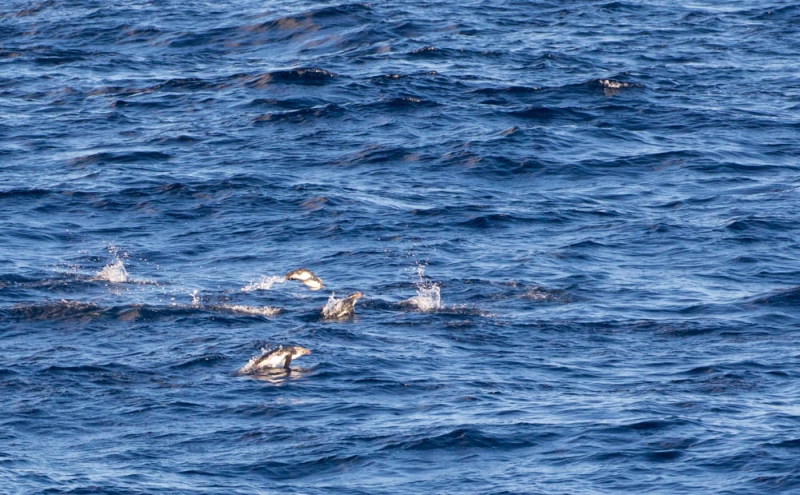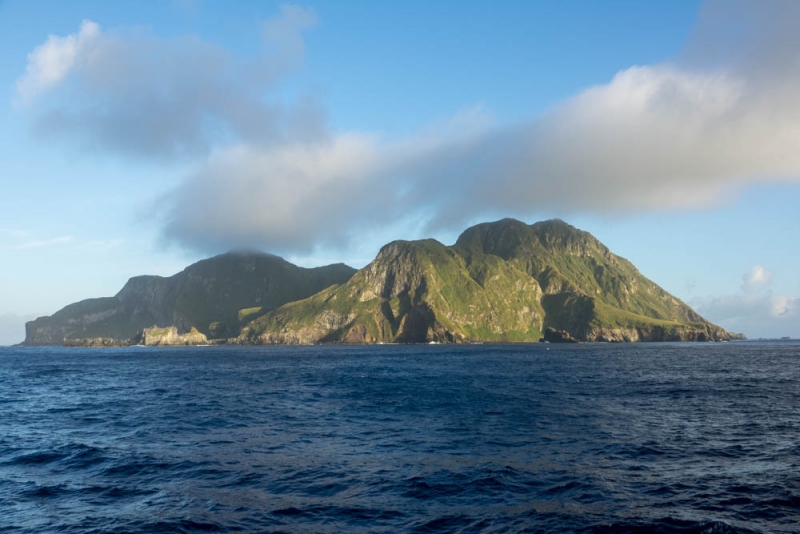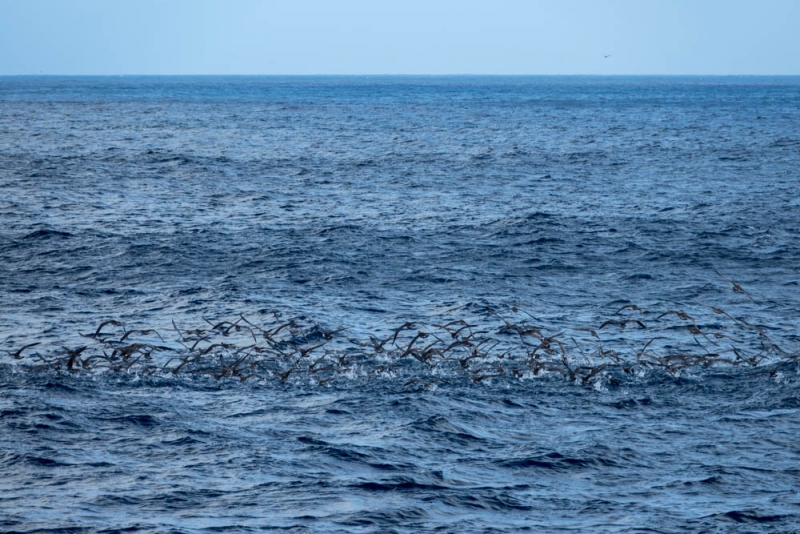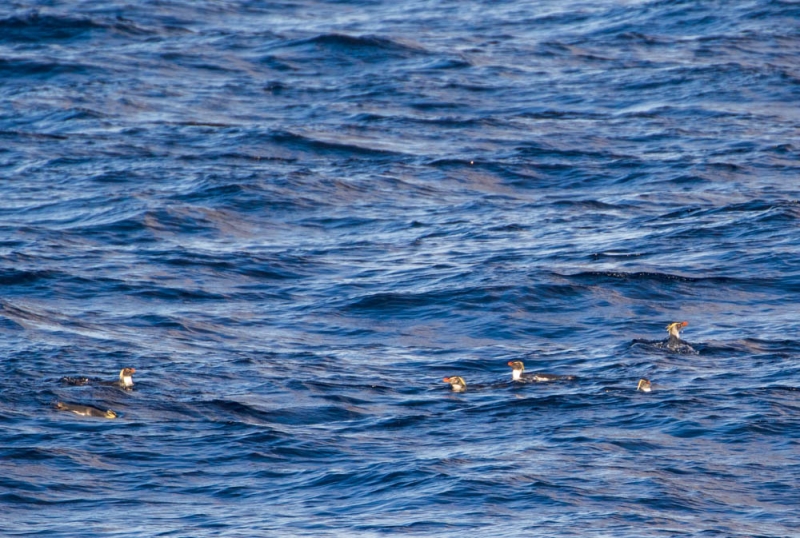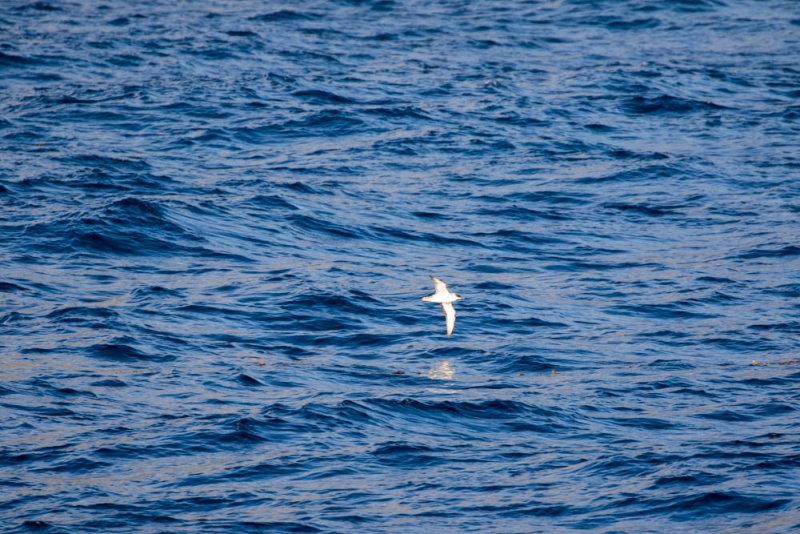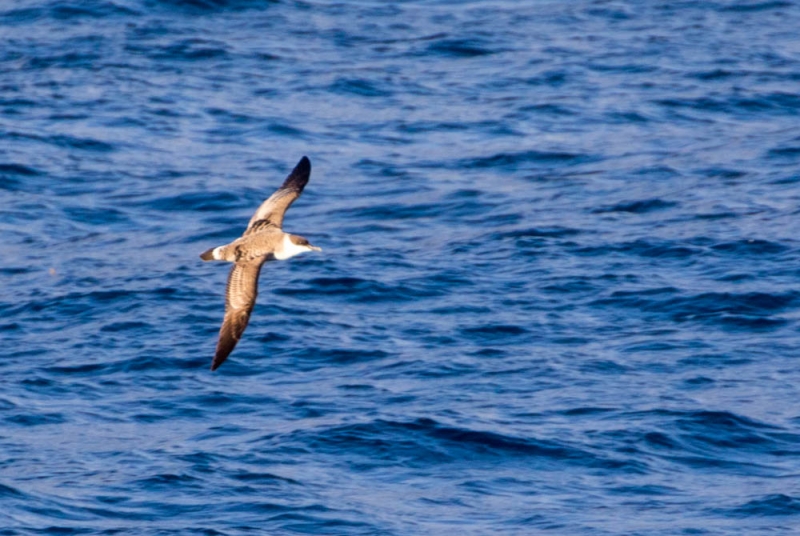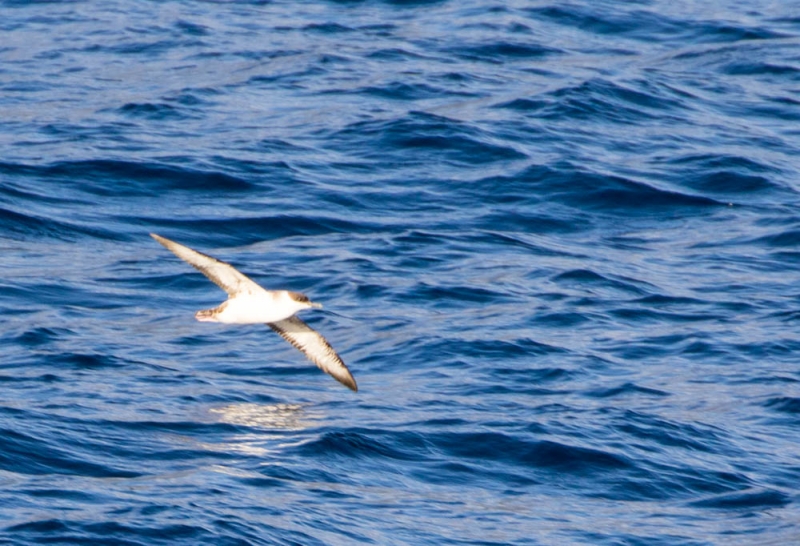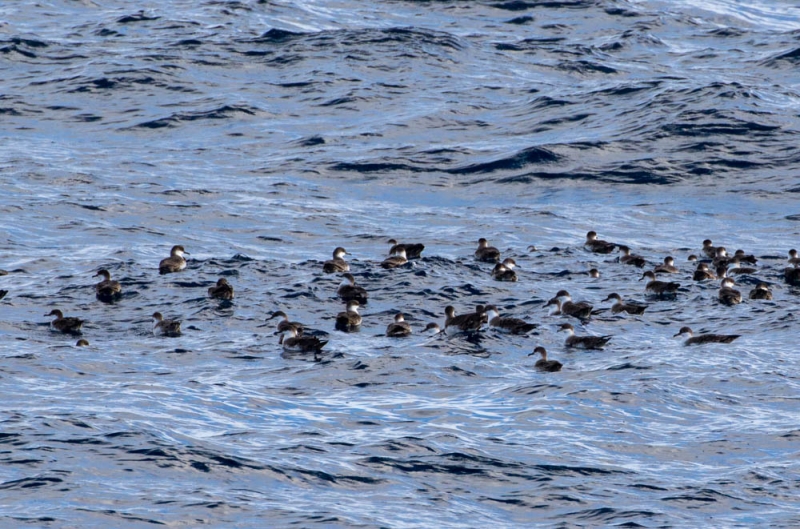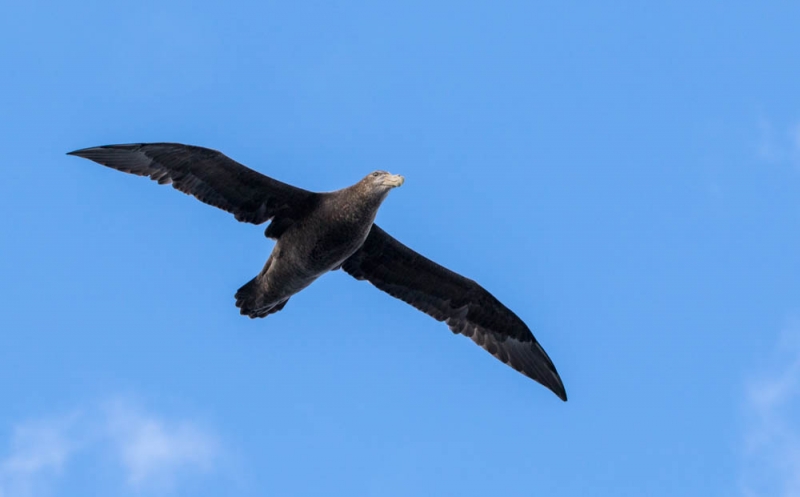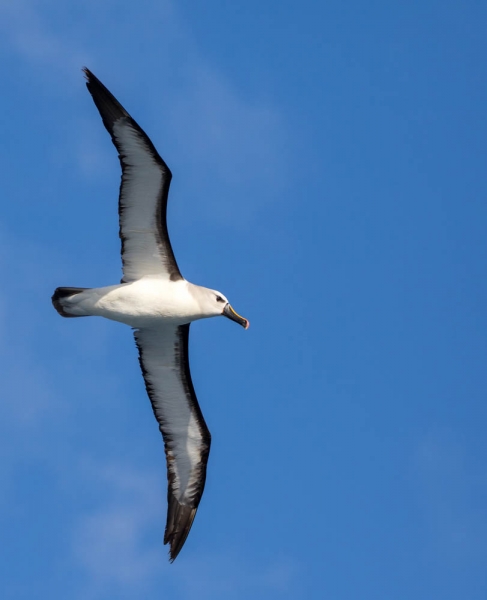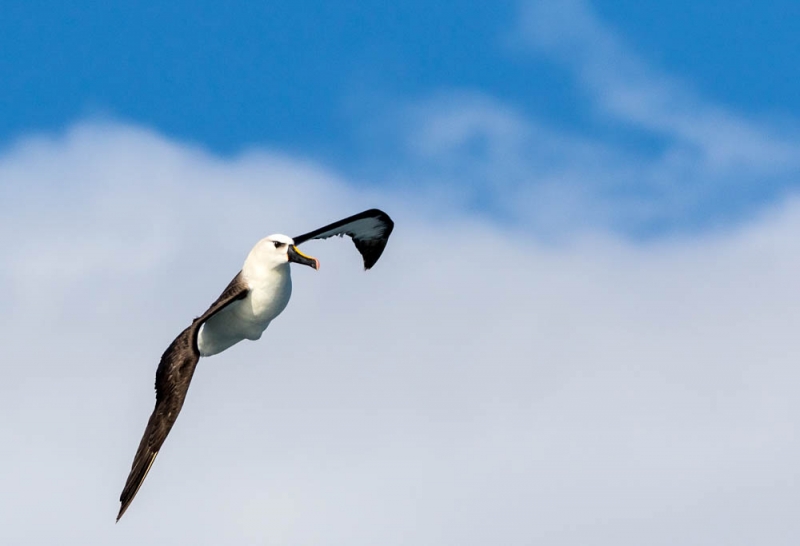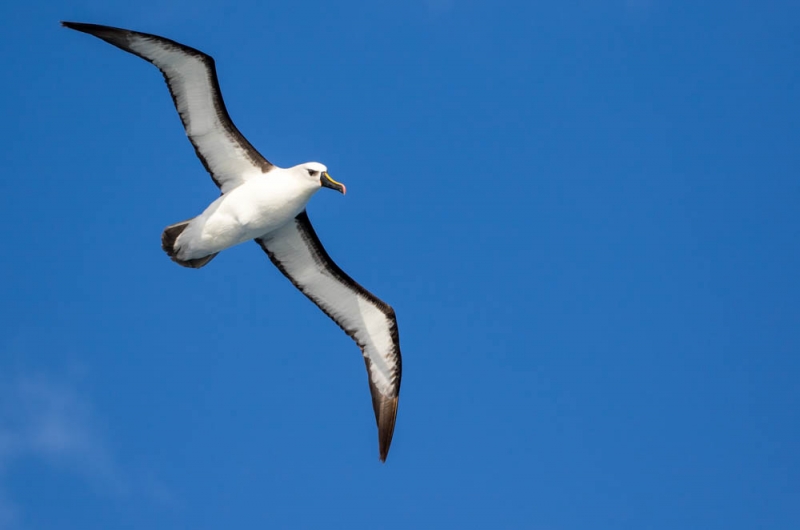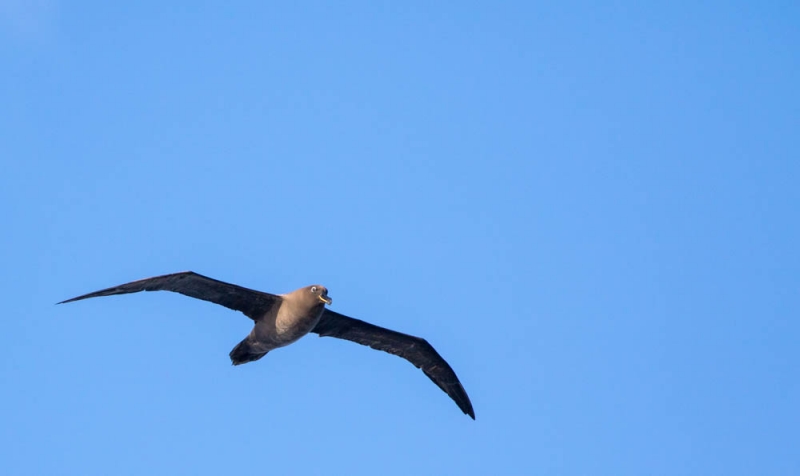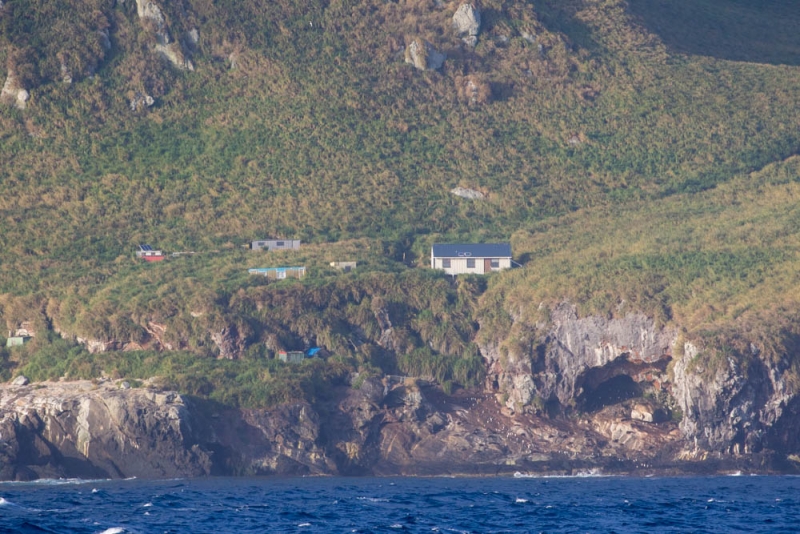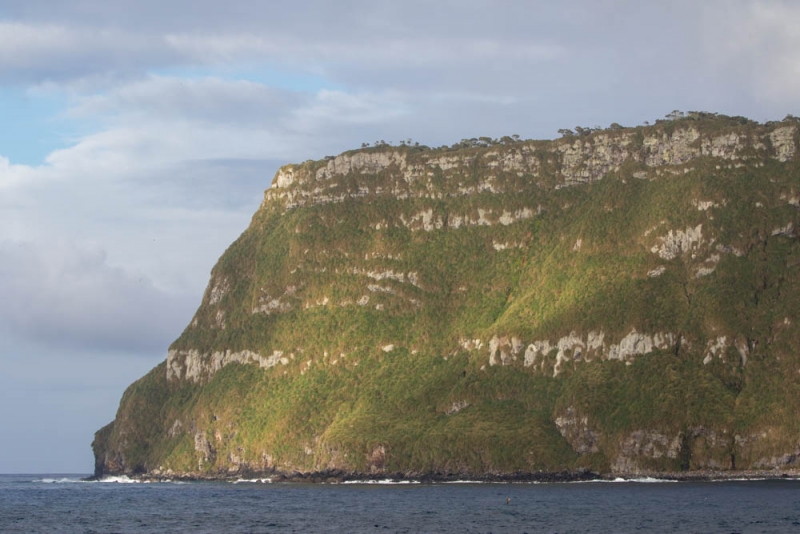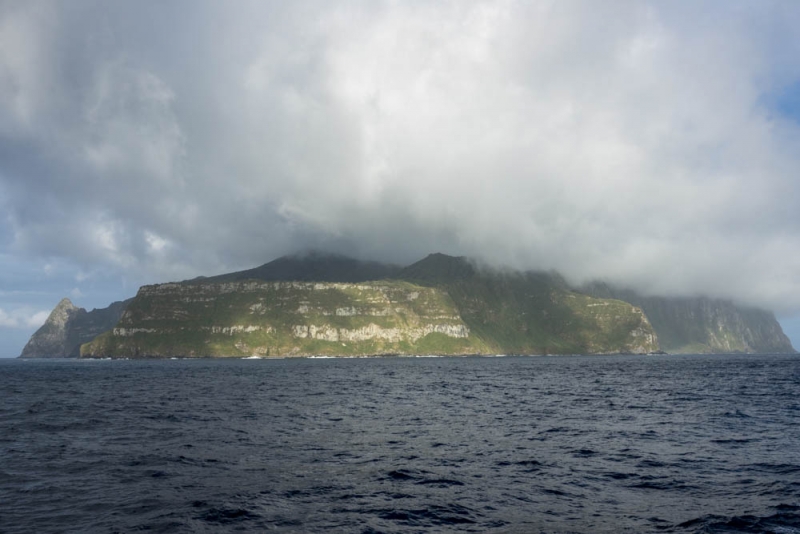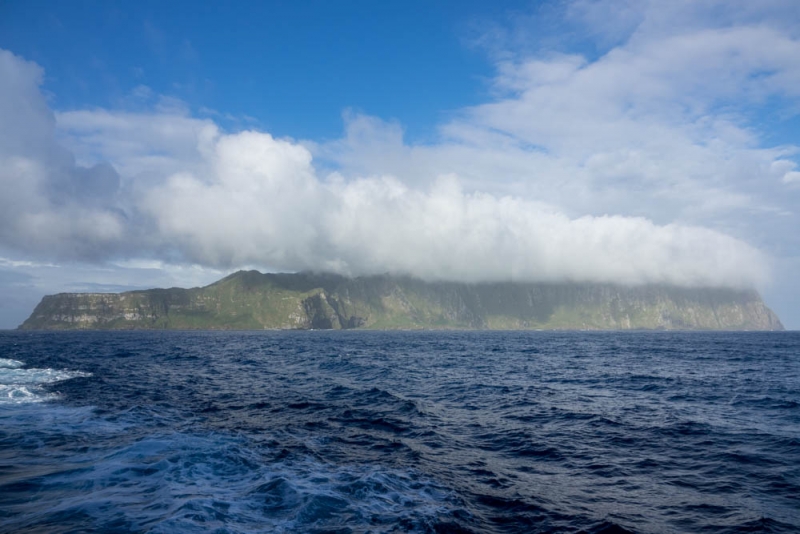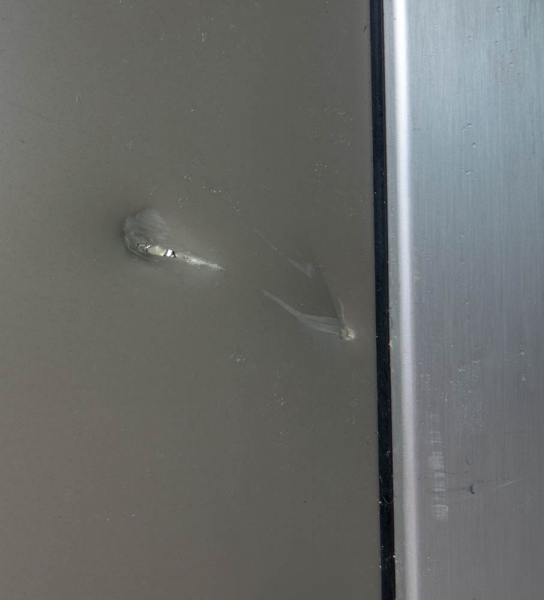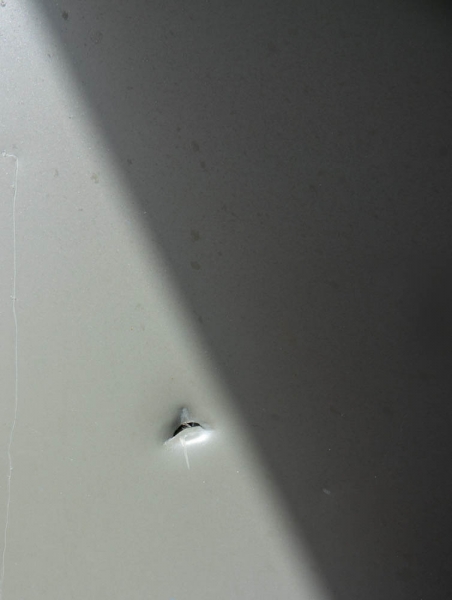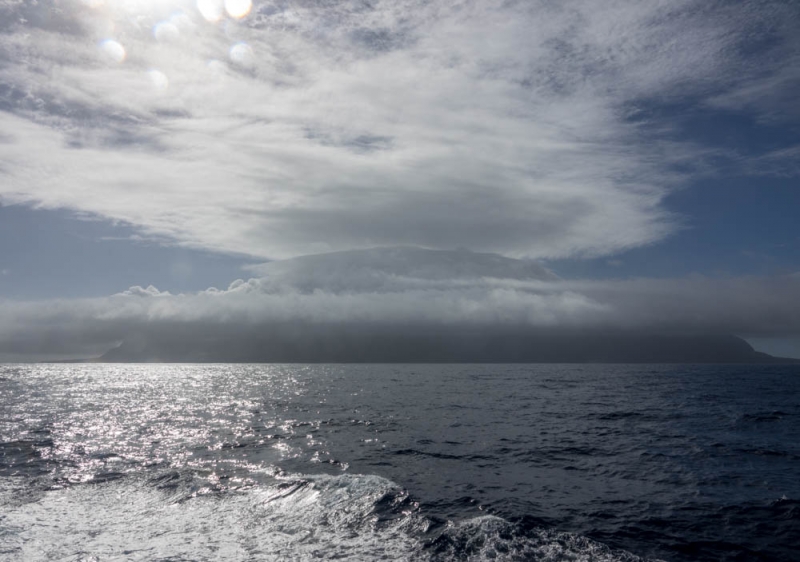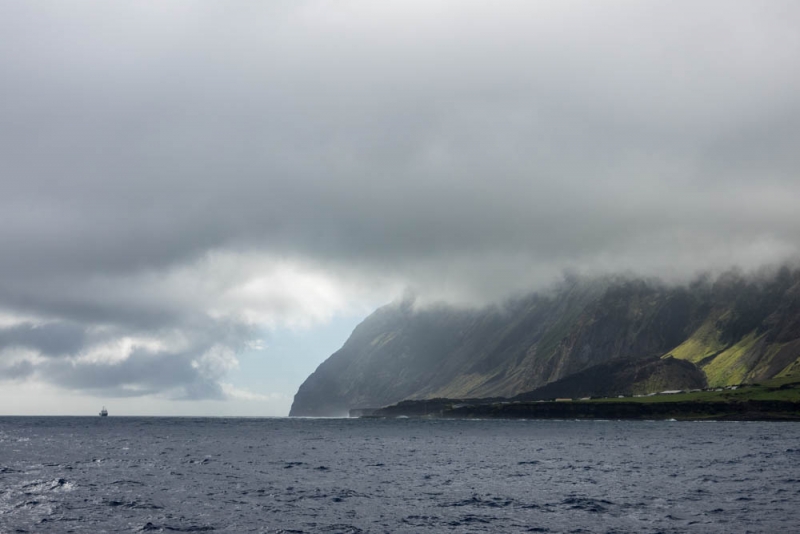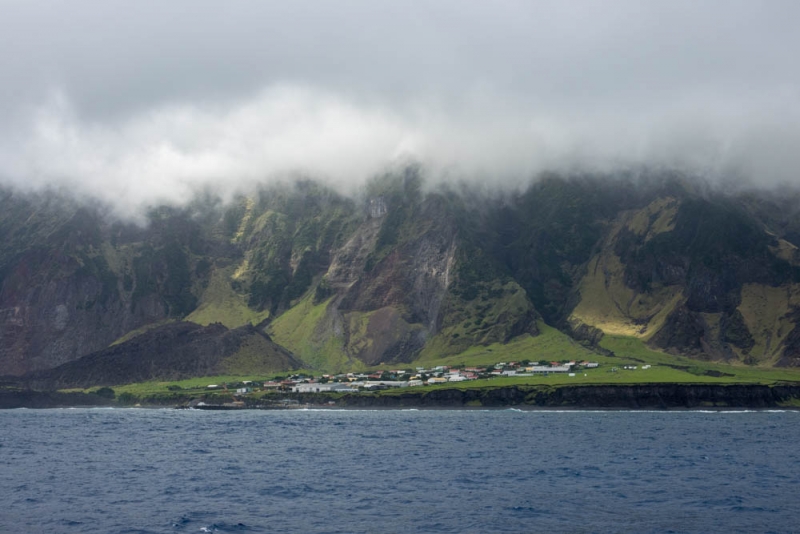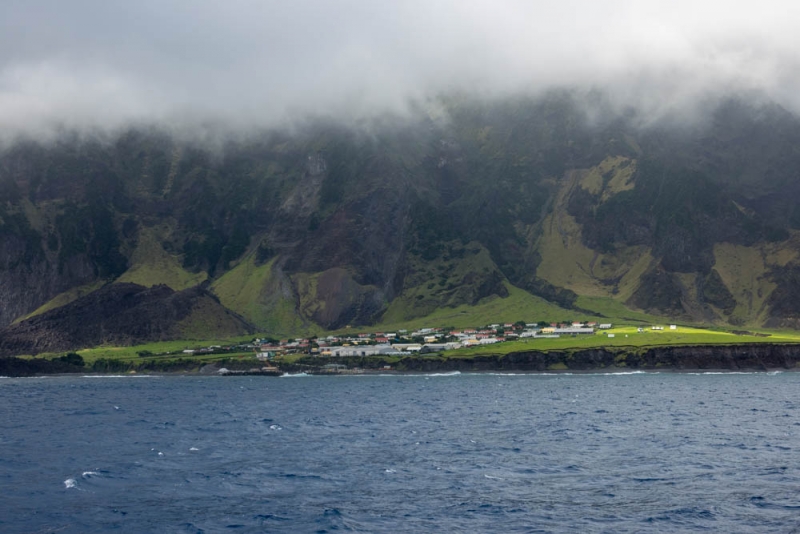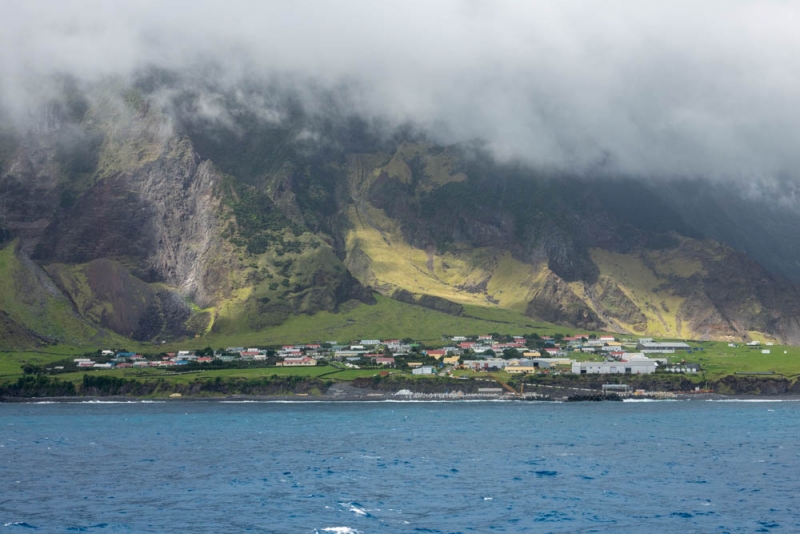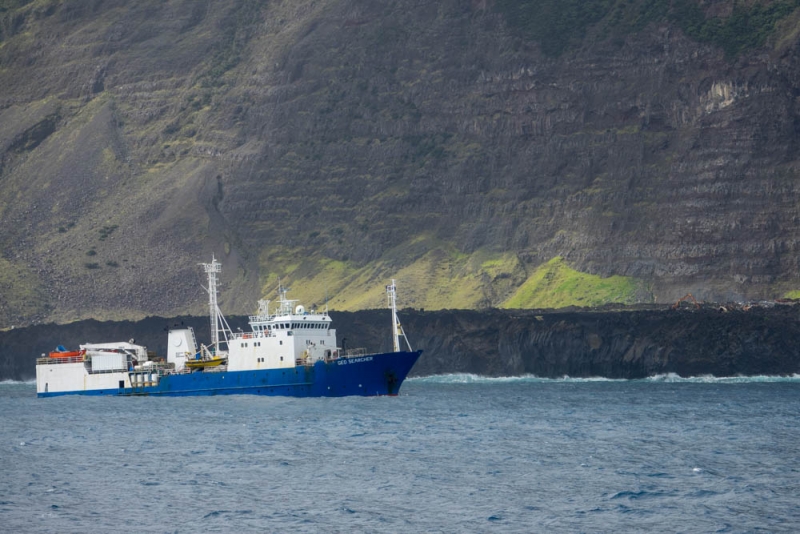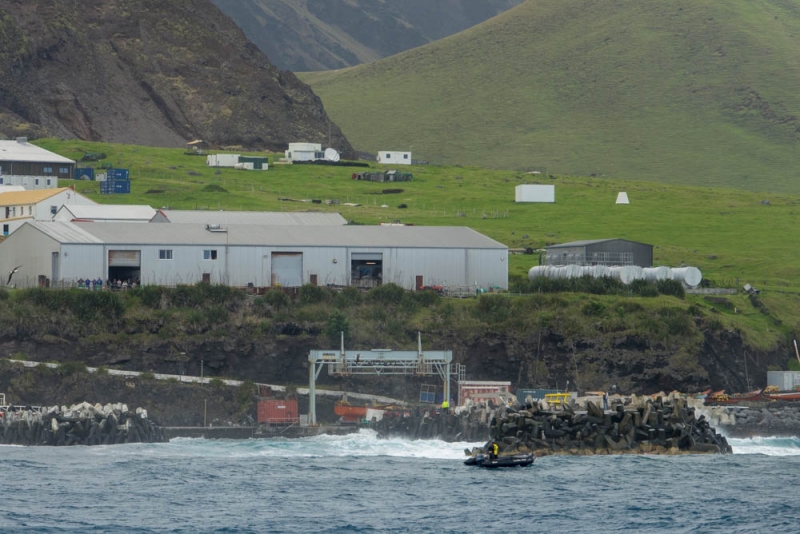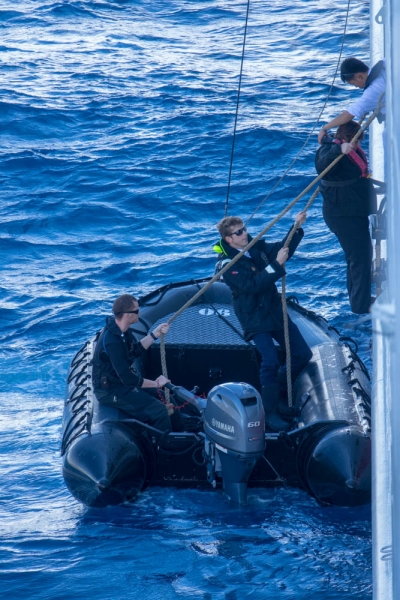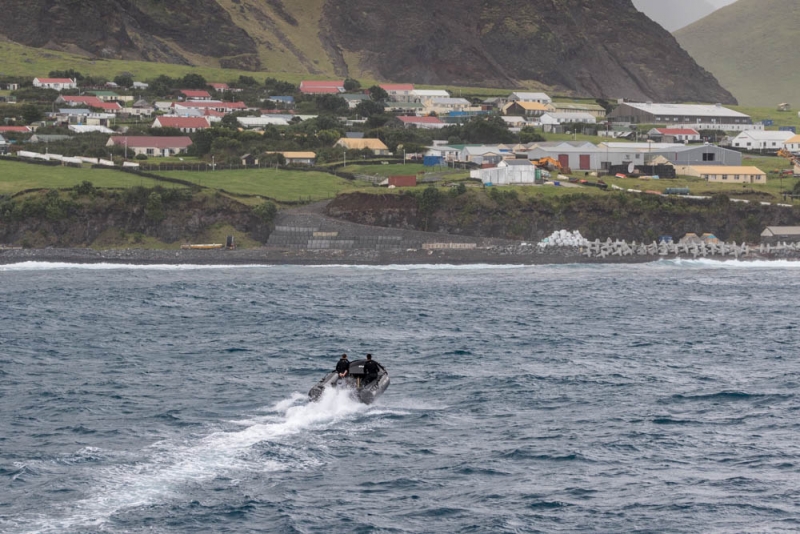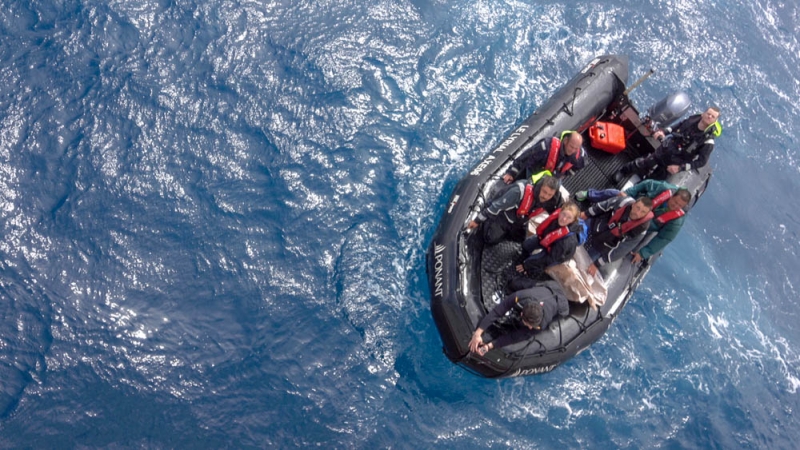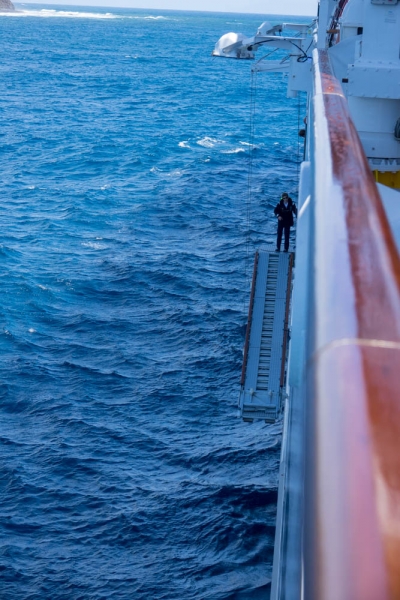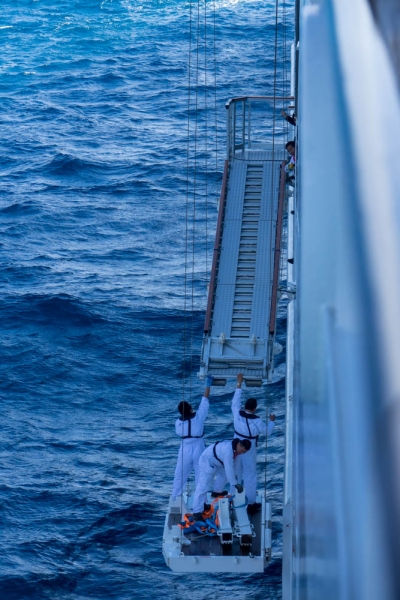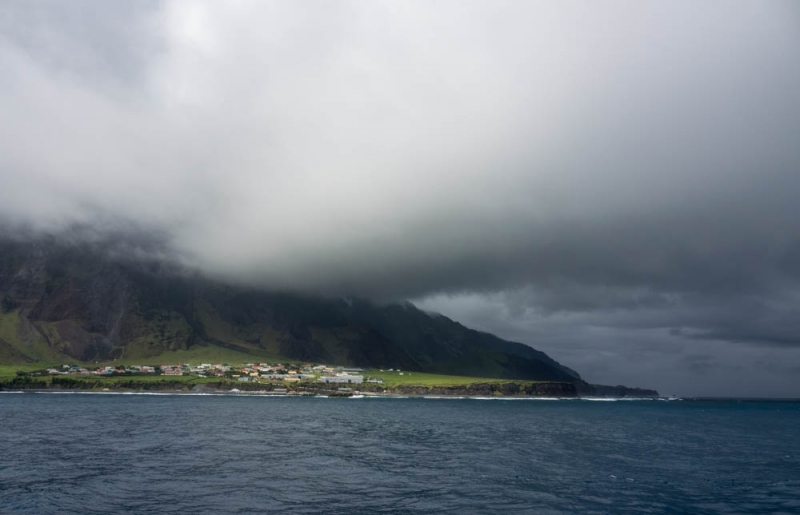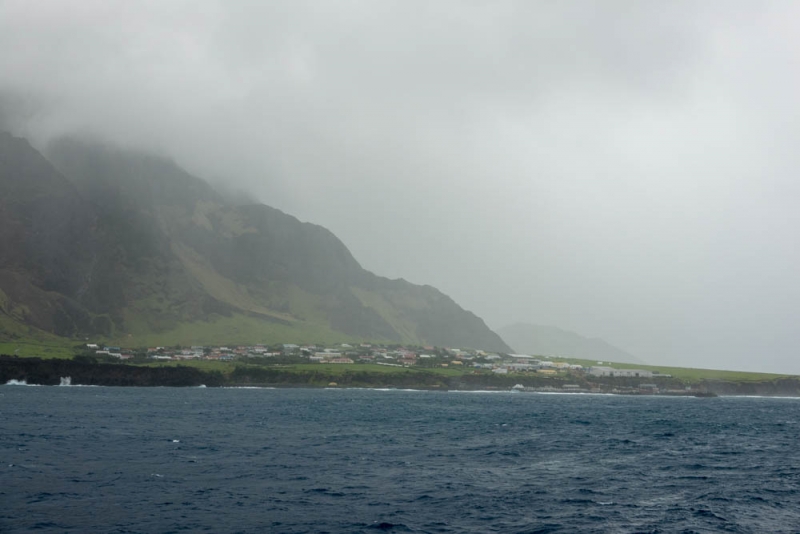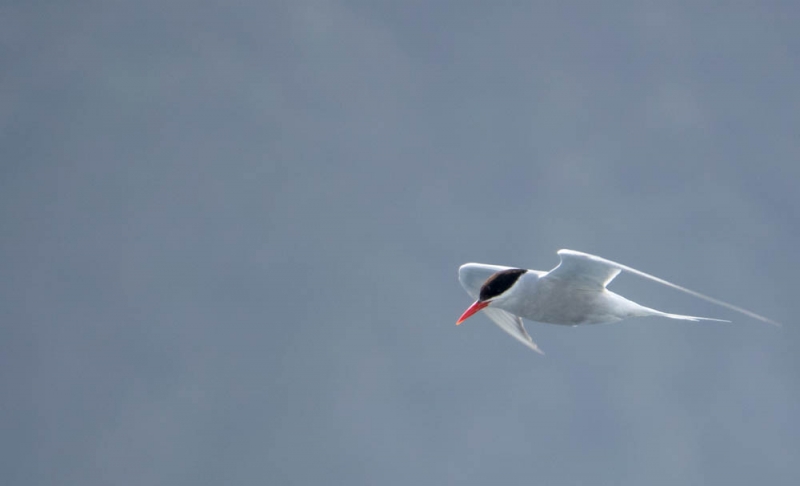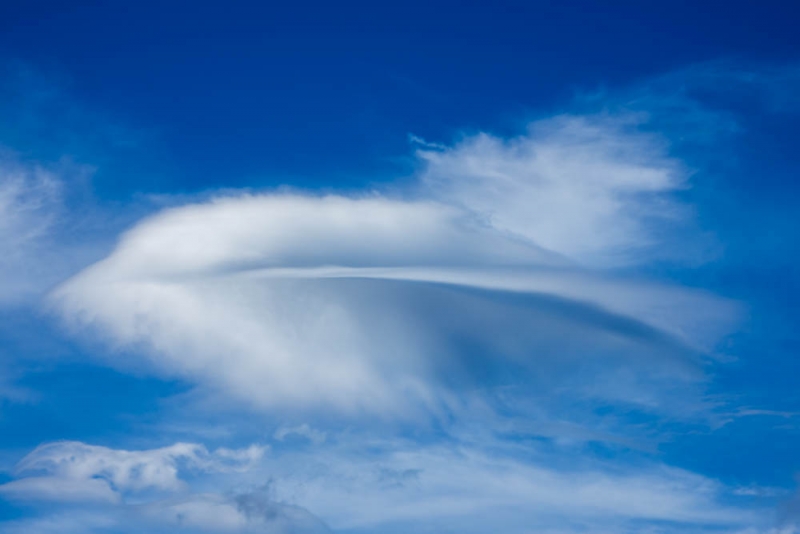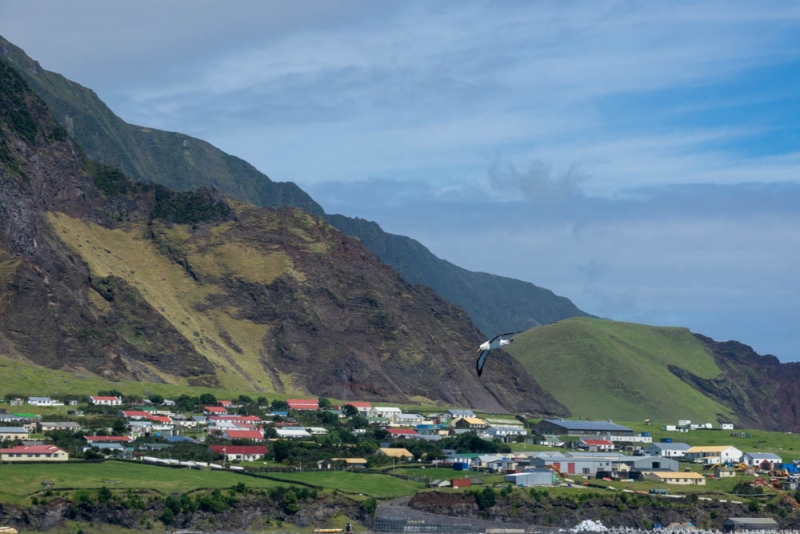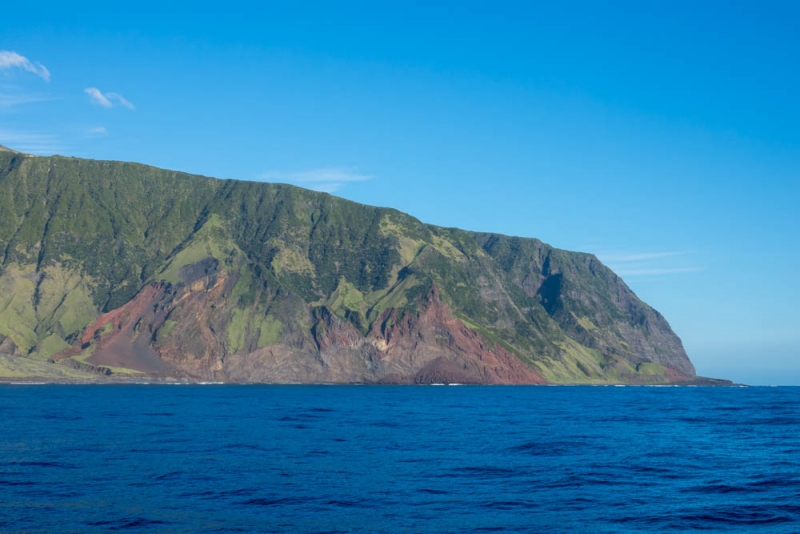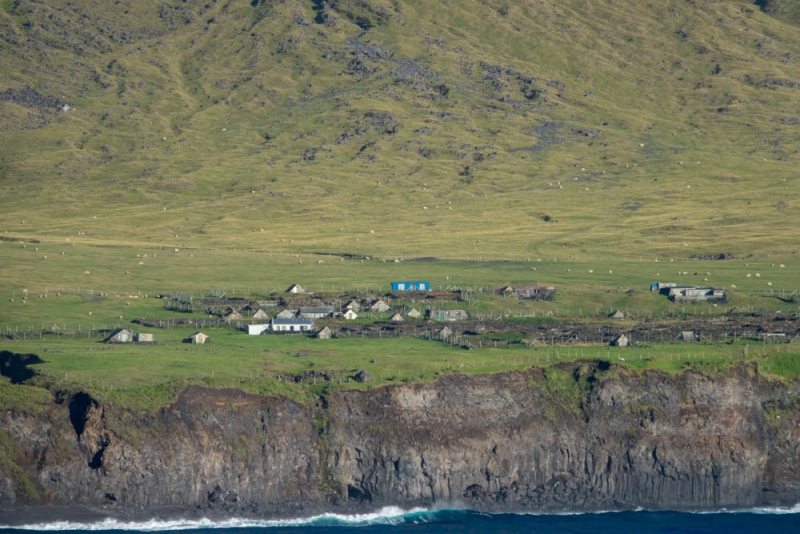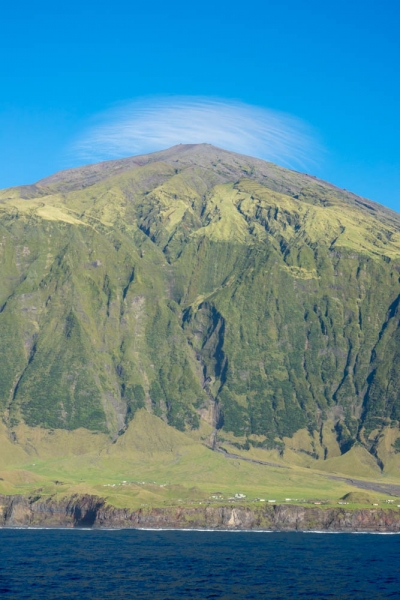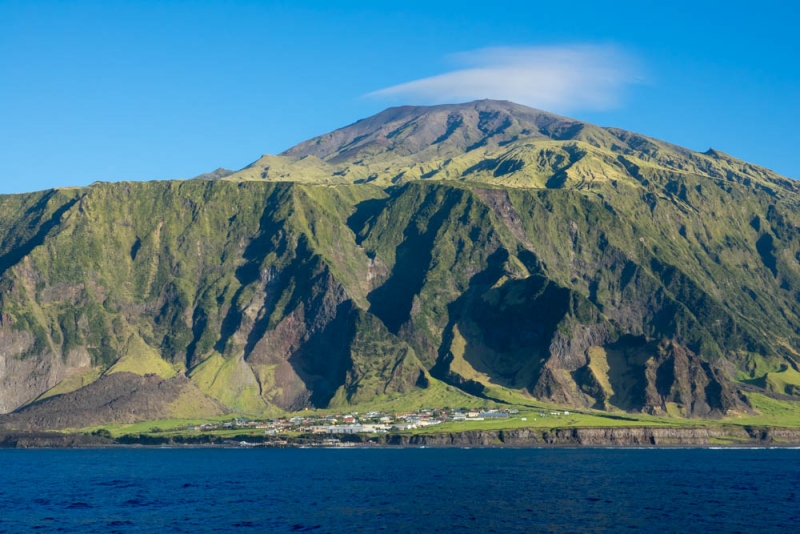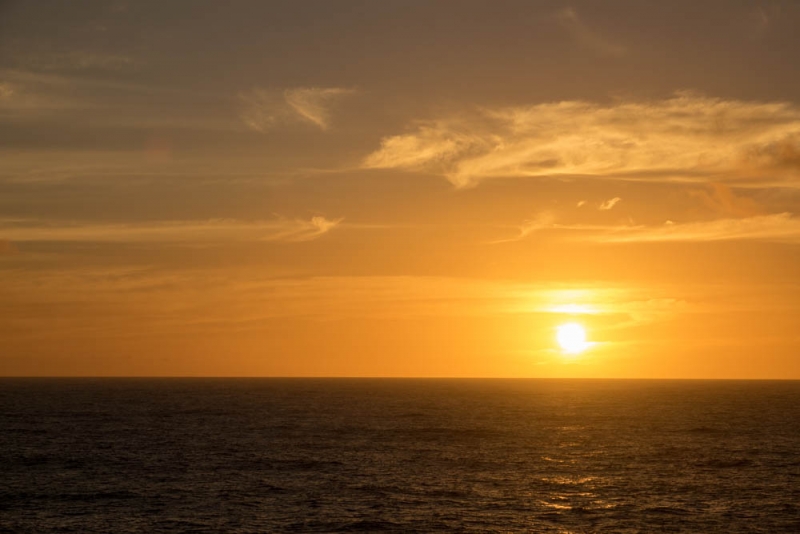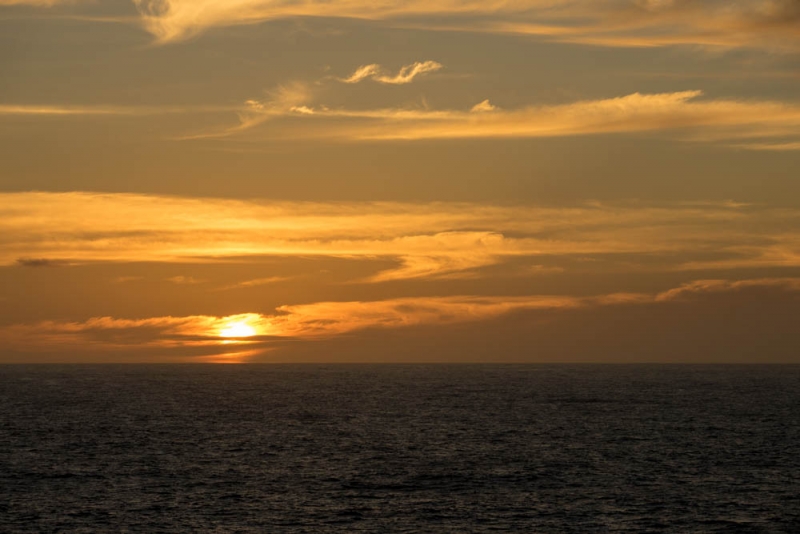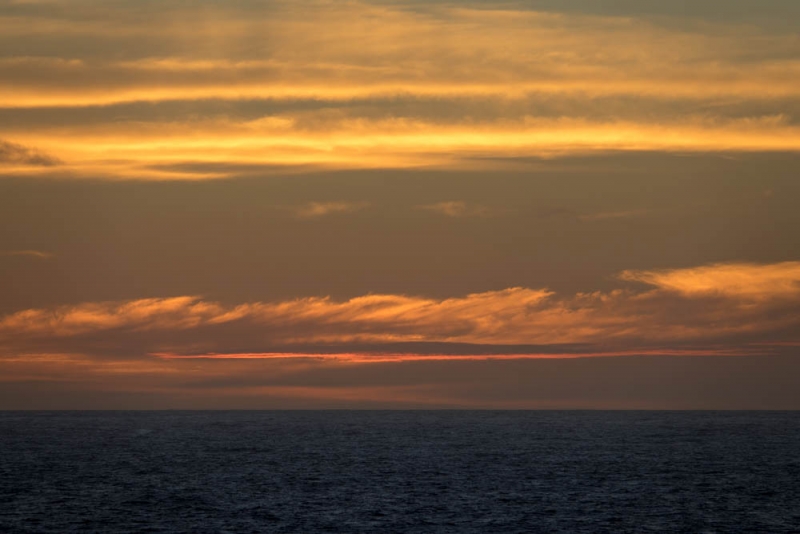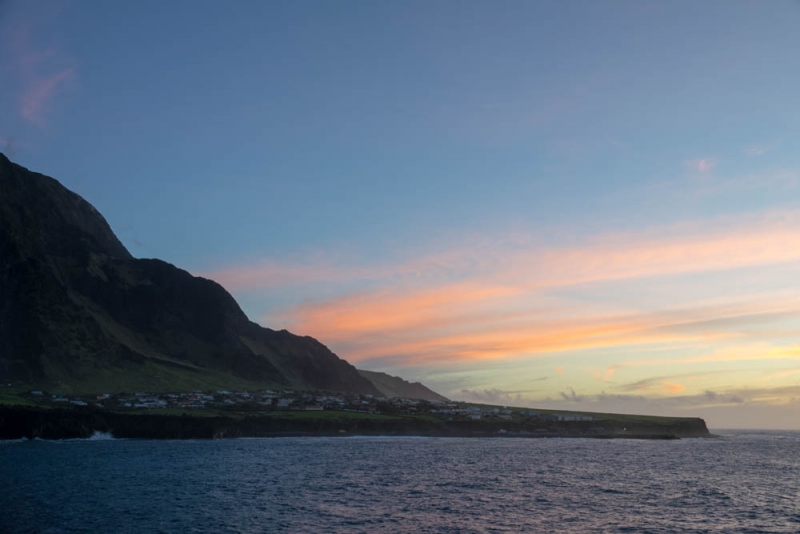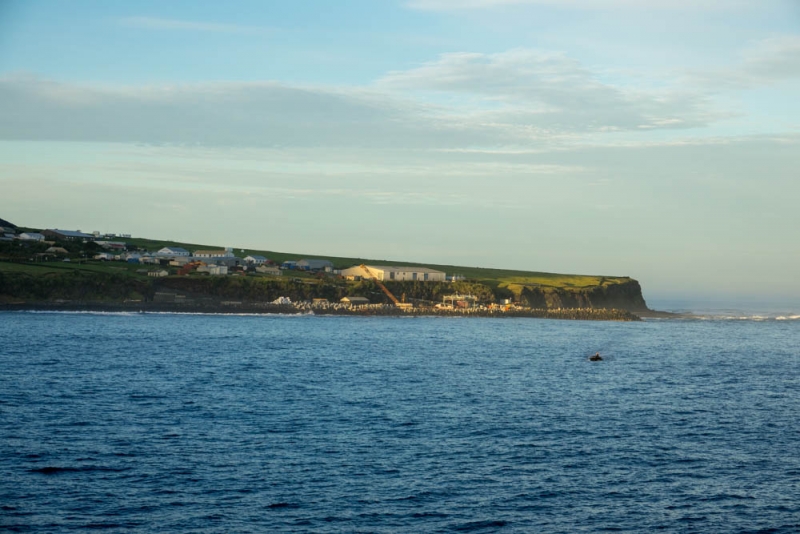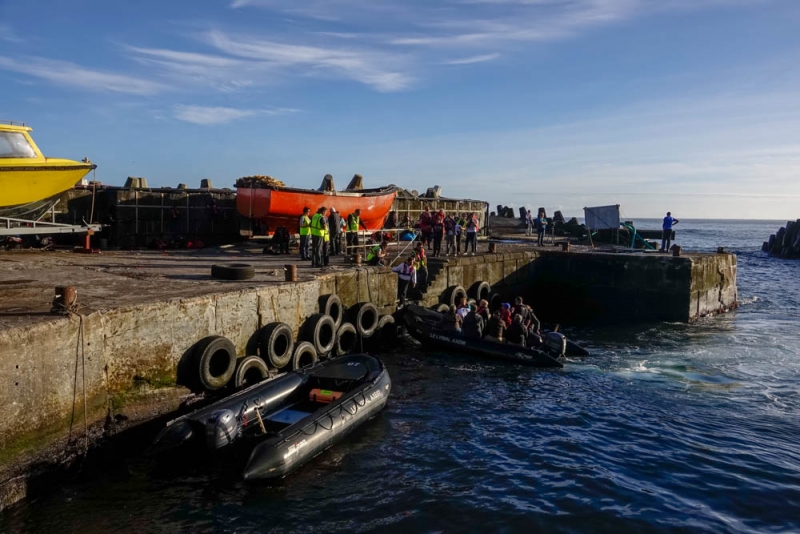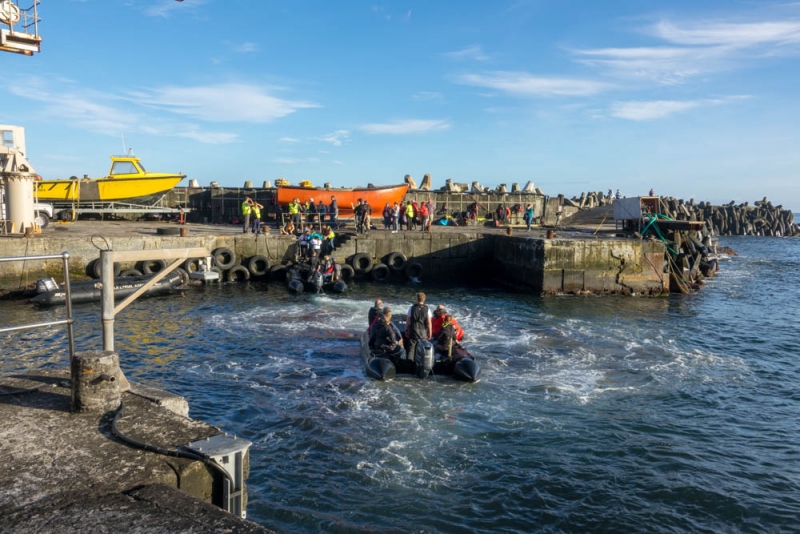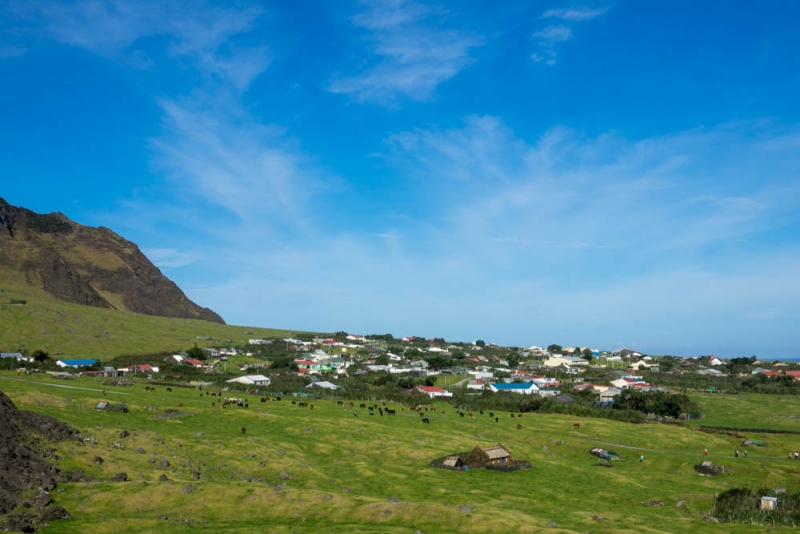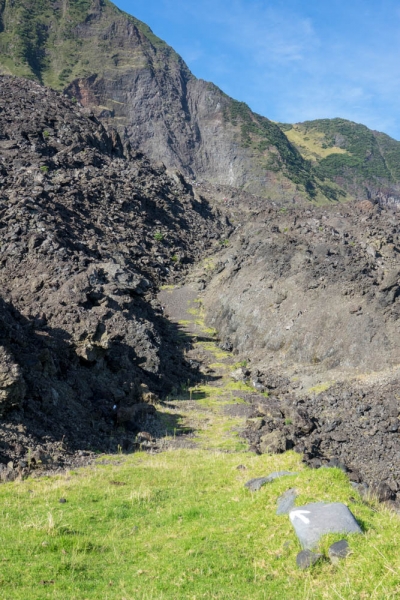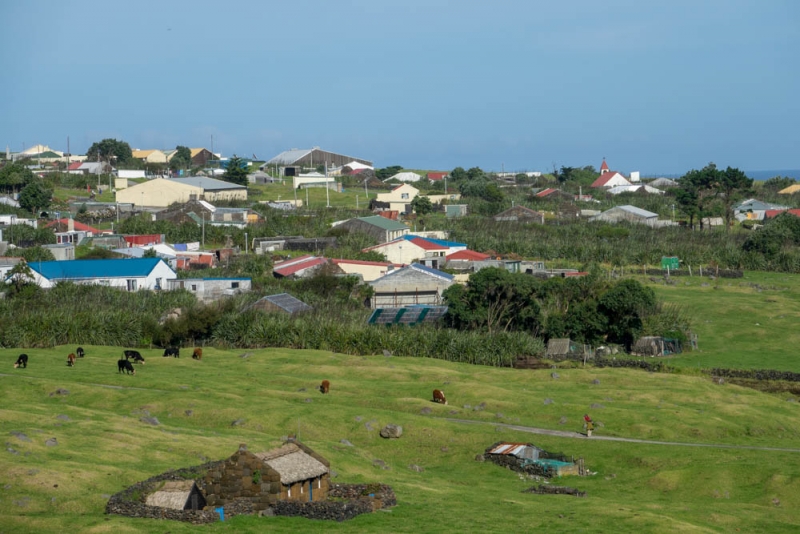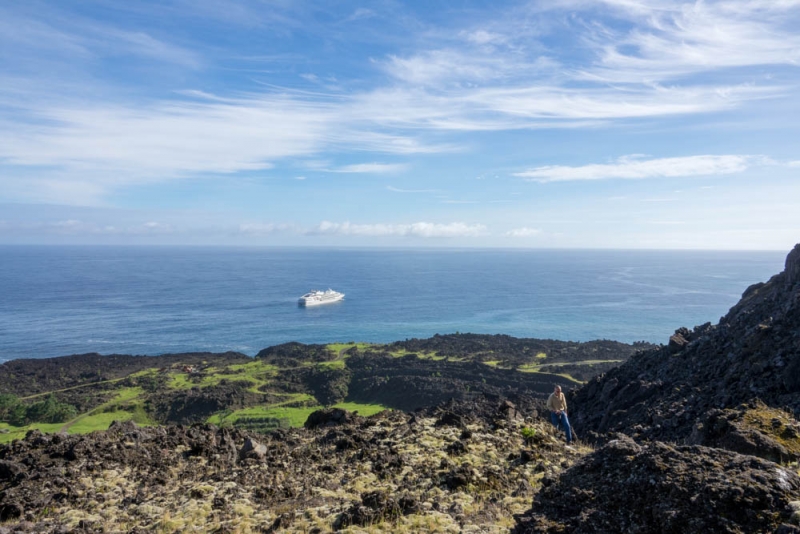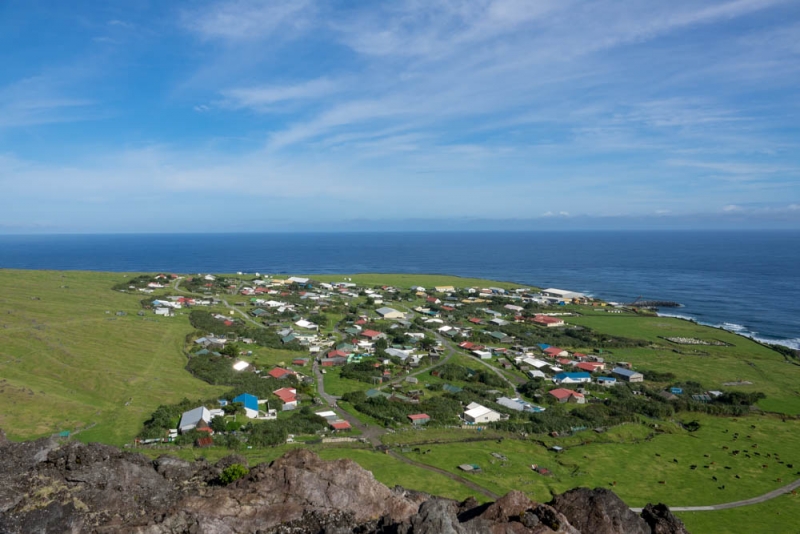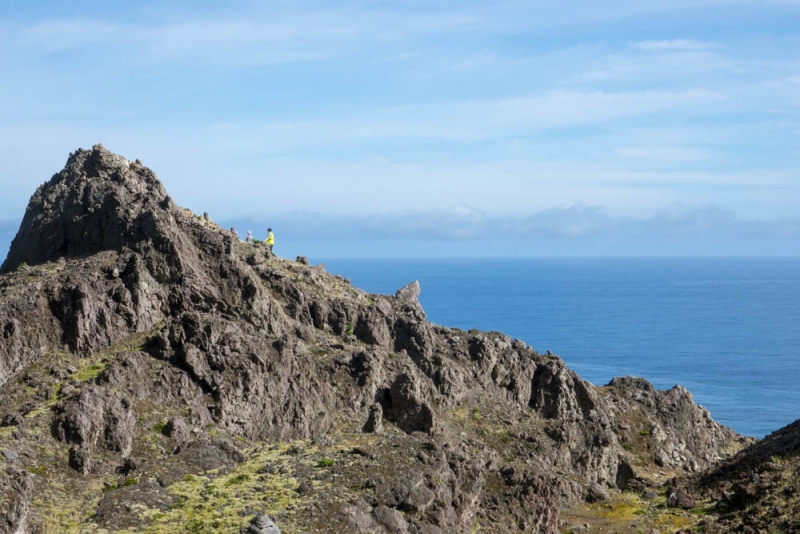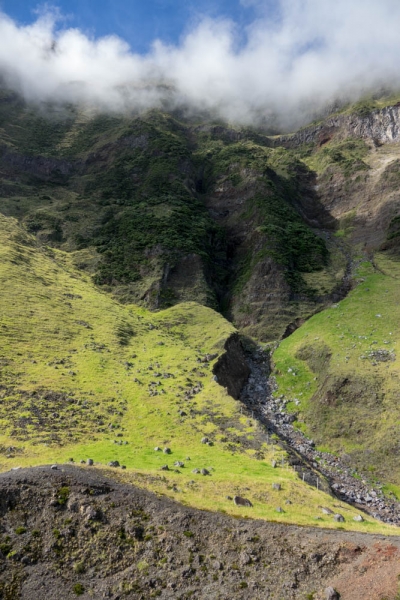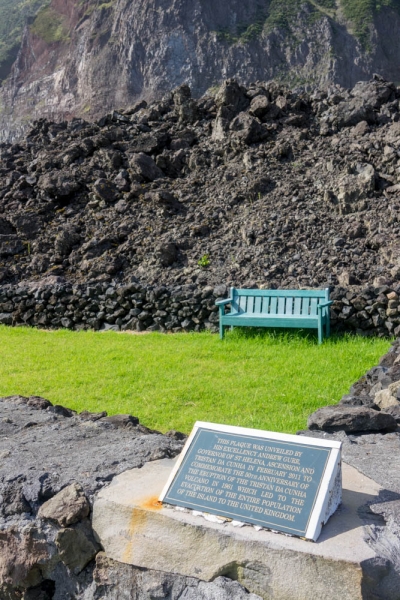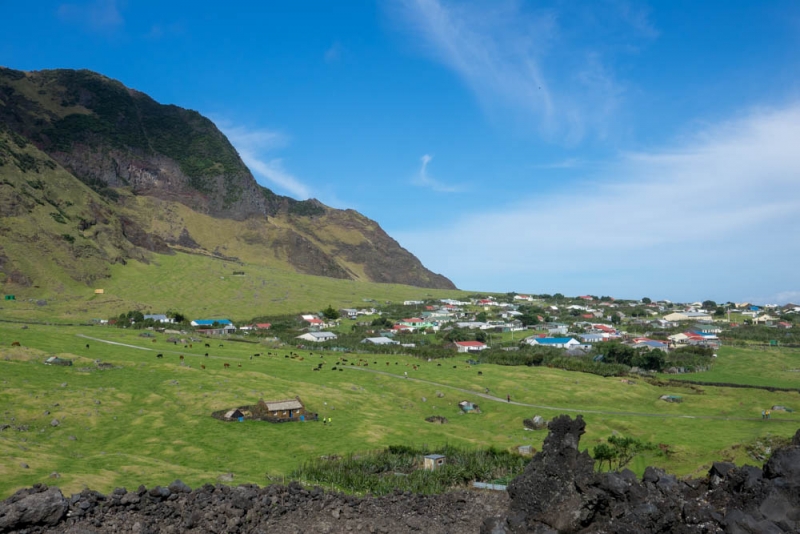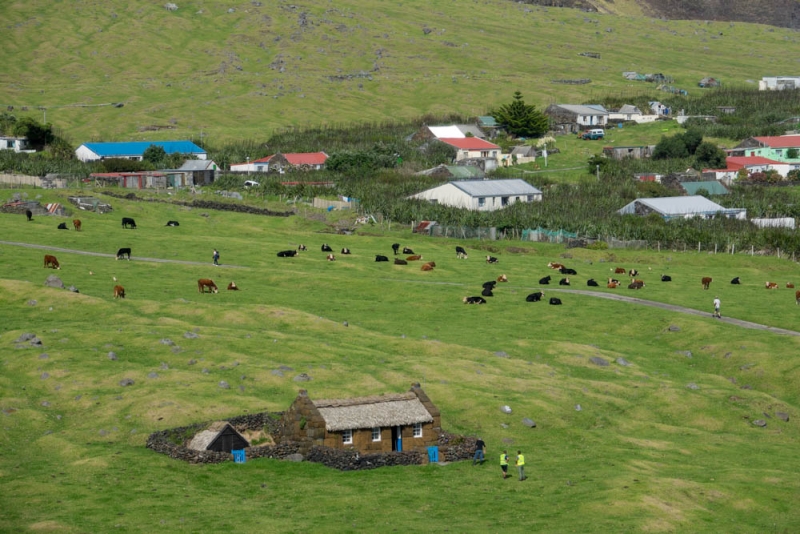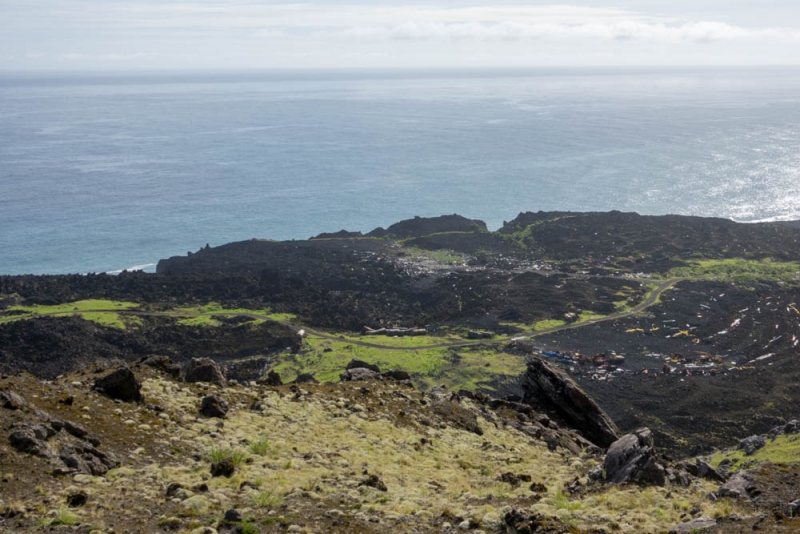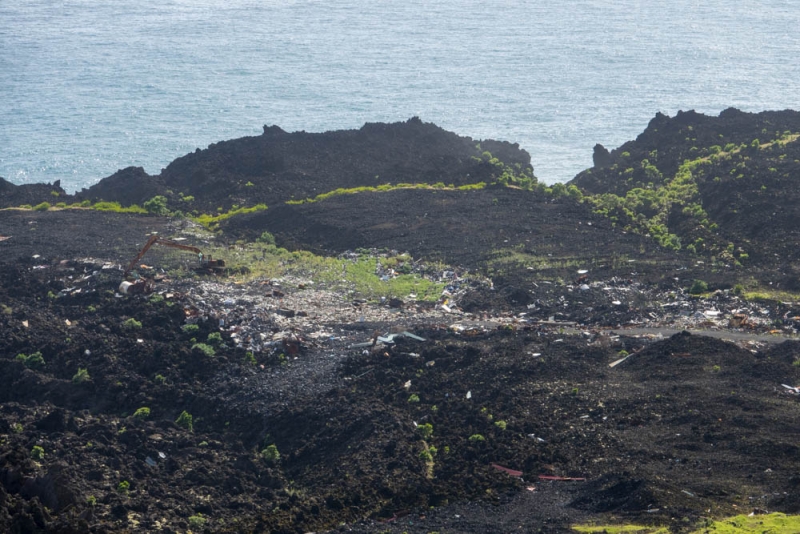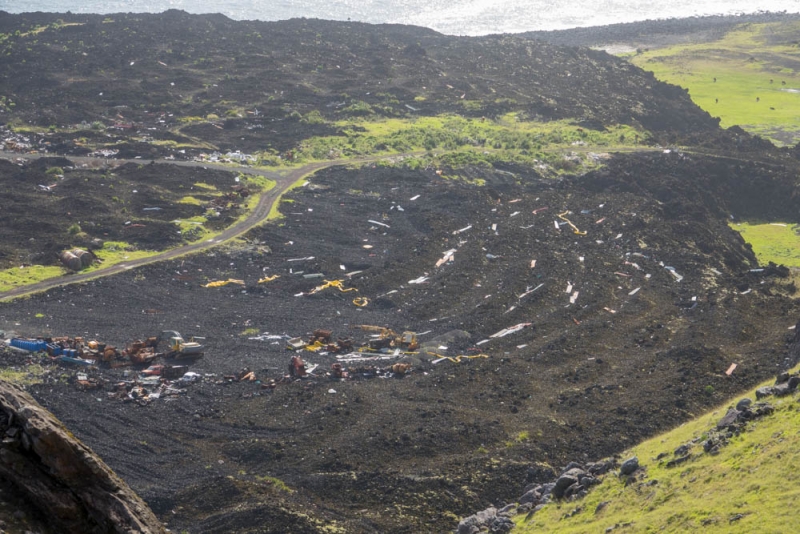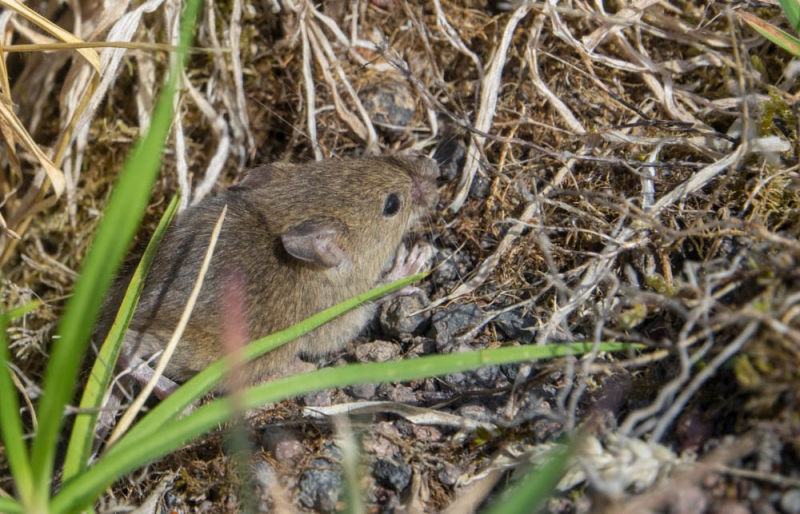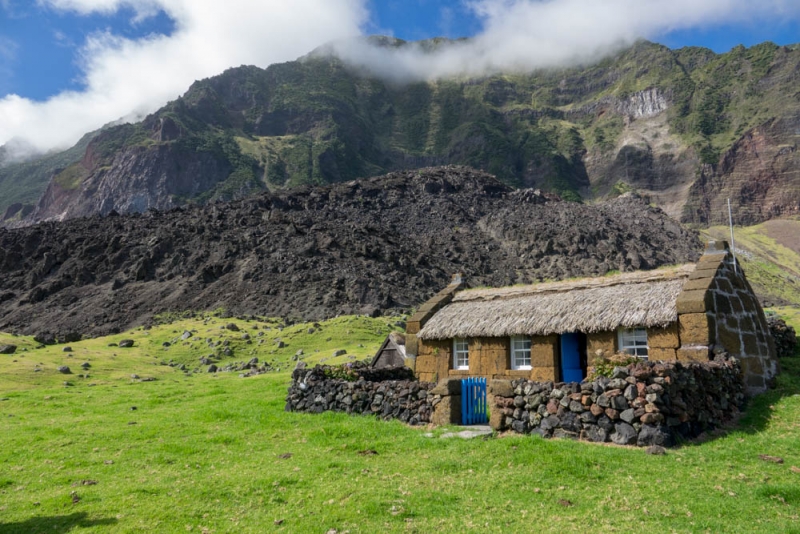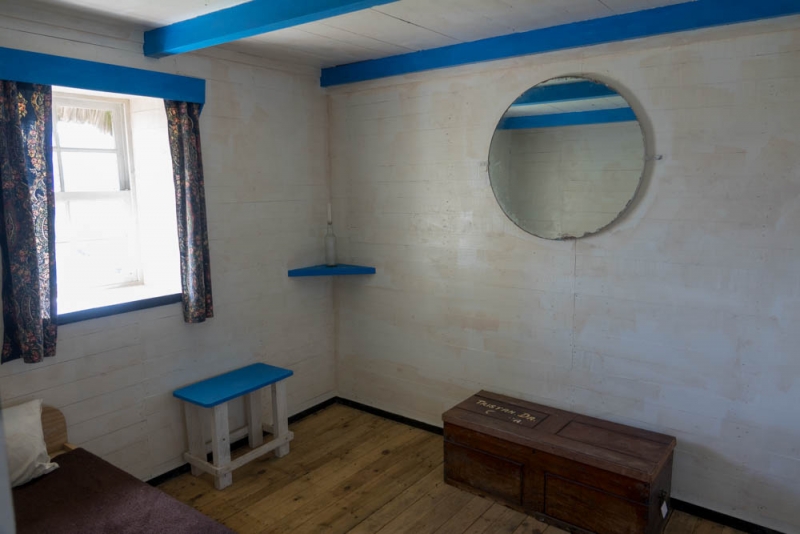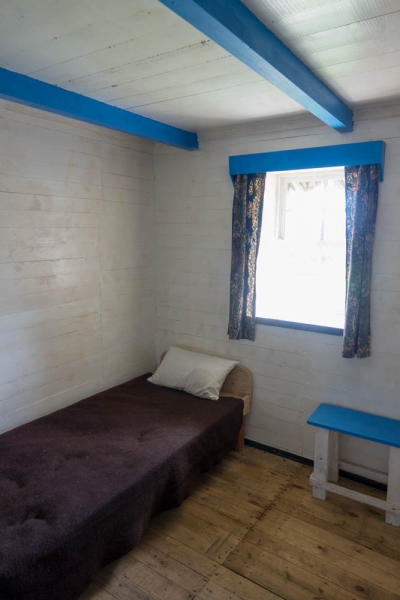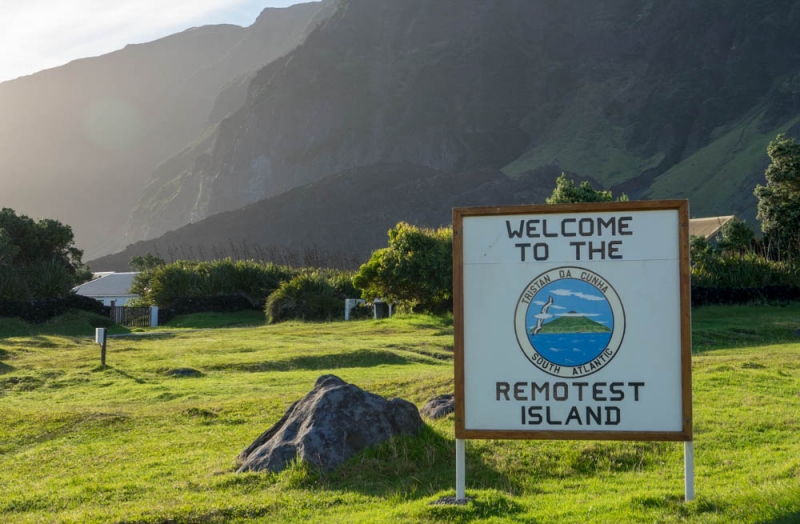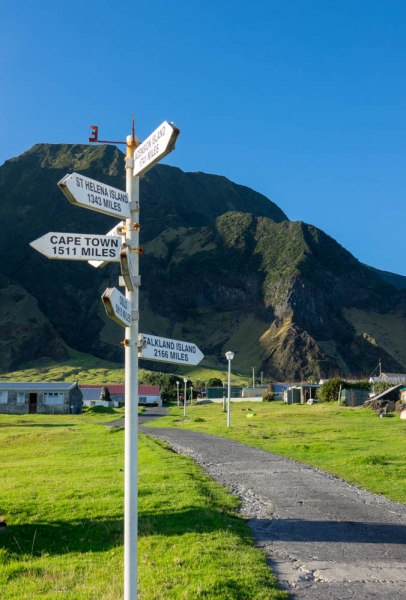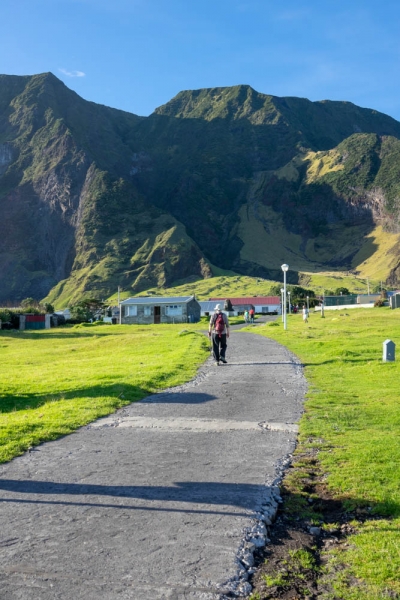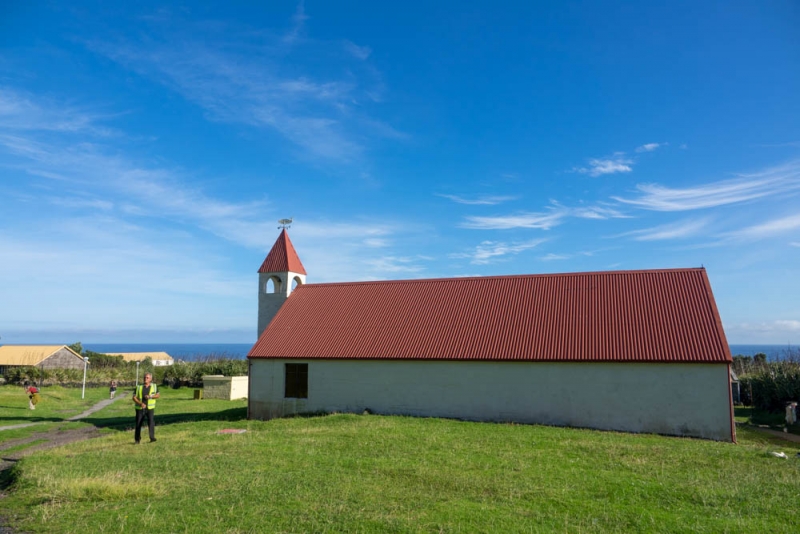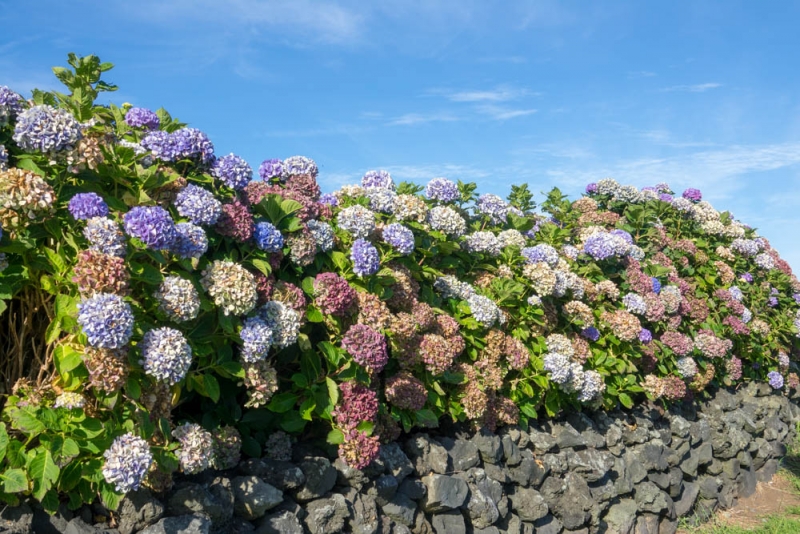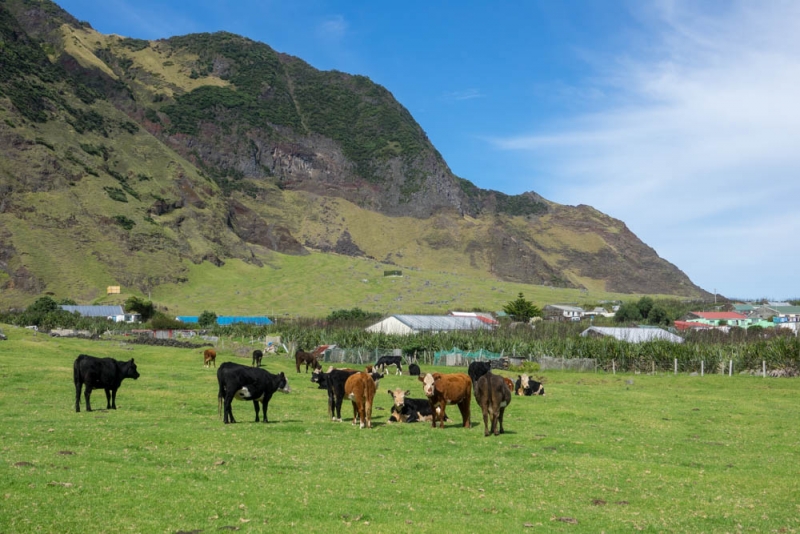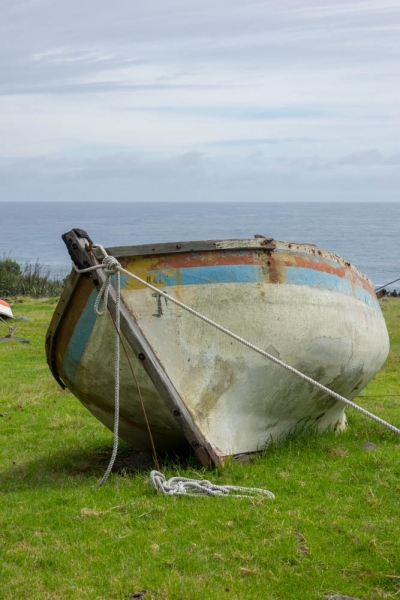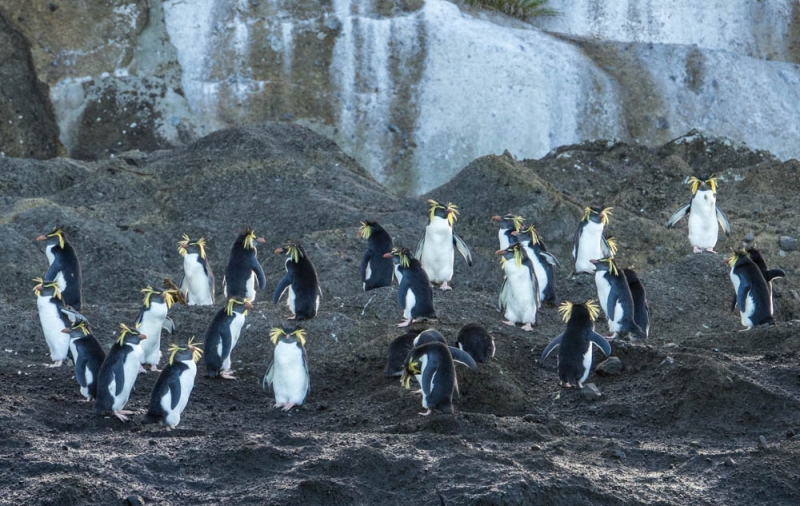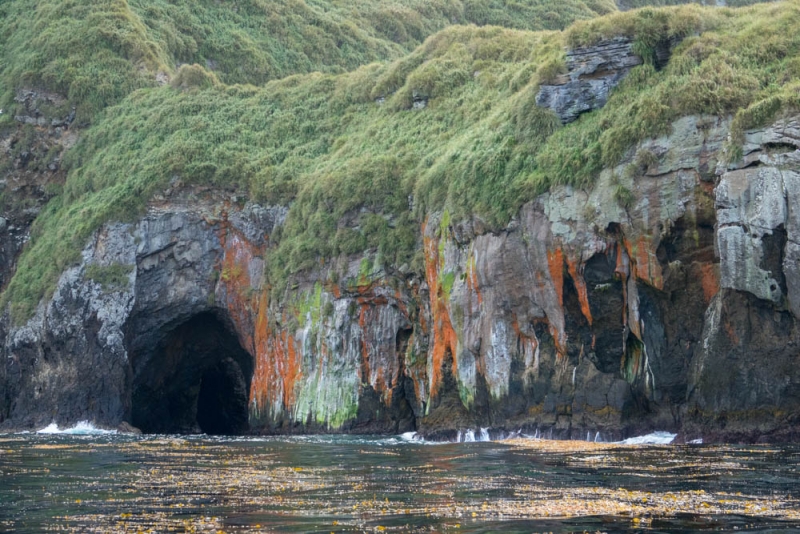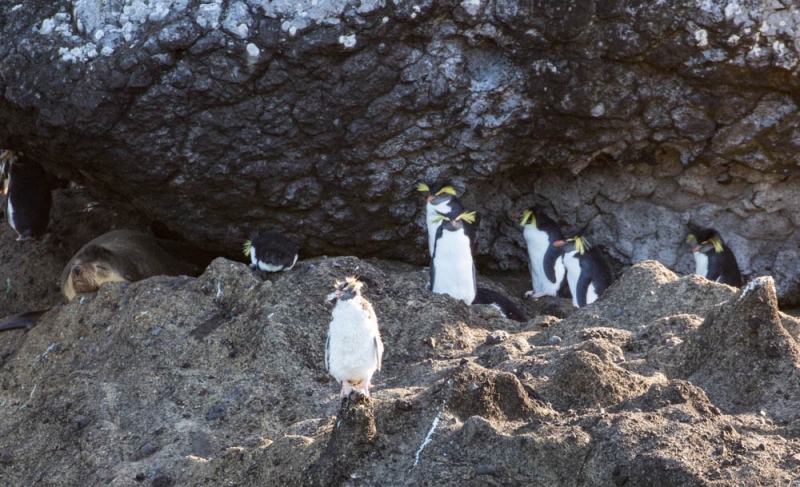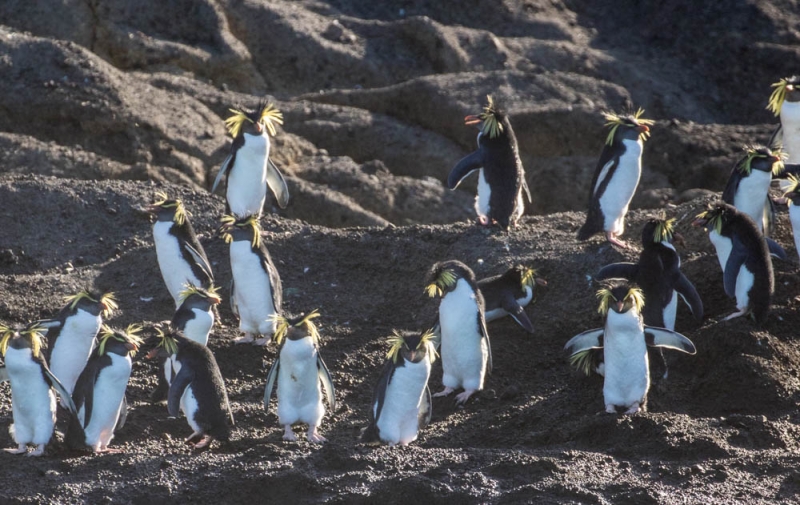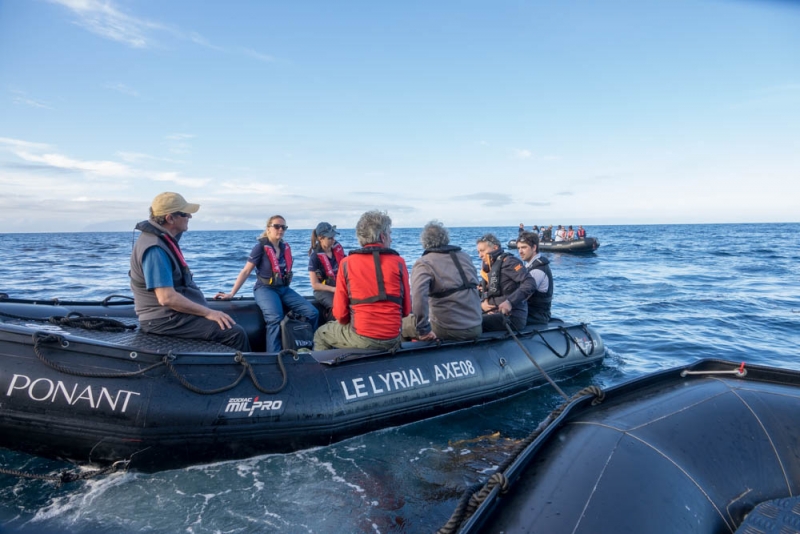Friday March 16, 2018
We arrive at Nightingale Island in bright, sunny conditions, and a heavy swell that puts paid to a landing or zodiac cruise. Given that we haven’t picked up a local guide, I’m struggling to see how an extensive landing will be possible, let alone a hike similar to my last visit in 2012. Commandant Garcia announces that he intends to circumnavigate the island, before heading to Inaccessible Island and Tristan da Cunha.
Nightingale Island is in the bright early morning sunlight, with plenty of sea birds around the ship and some porpoising Northern Rockhopper penguins in the water.
There are Greater Shearwaters in the air and preening on the sea surface, Yellow-Nose albatrosses, Sooty Albatrosses, Skuas and Giant Petrels. The brightening blue sky and the directional sun make for some fabulous conditions for photographing the birds.
Some of the Tristan da Cunha residents have “holiday houses” on Nightingale Island, which have the bare necessities, with a couple of solar panels visible on one of them.
Inaccessible Island is nearby, and Commandant Garcia does a sail by on the way to Tristan da Cunha. With its forbidding cliffs, the Expedition Leader describes landing at Inaccessible Island as ‘impossible’, when she really means ‘difficult for the 20% of passengers capable of doing it’.
The crew taking advantage of the reasonable conditions and are busy reinstalling the privacy partitions on the balconies. The partitions are steel, and the photos below show the damage a wave-borne chair leg can do.
It is about an hour to sail to Tristan da Cunha, shrouded in the cloud from a distance.
We arrive at Tristan da Cunha to relatively bright sunny conditions, and a strong swell. Another ship is anchored off the coastline, and the settlement known as the ‘Edinburgh of the Seven Seas’ is nestled on the gentle rise of the hillside.
The other ship at anchor is the Geo Searcher, a fishing trawler, that is waiting to unload its catch and to pick up some passengers. One of the islanders later tells me that the Geo Searcher is regarded as luxurious transport to Cape Town as it has cabins with ensuites, rather than one toilet and shower shared between all the passengers.
A zodiac is dispatched to the port, and it is obvious from on the ship that the zodiac is having to wait several minutes before the waves on the breakwater cease enough for the harbour master on the breakwater to signal that it is safe for the zodiac to enter Tristan’s tiny port.
The island’s immigration officers are brought on to the ship, and due to the swell breaking on the marina deck have to board the ship via a rope ladder on deck 2. It’s not easy for any of them.
The crew spends most of the morning trying to set up the gangway steps on the side of the ship to disembark the passengers onto zodiacs, but ultimately abandon it for safety reasons. My balcony continues its run of bad luck as a fly-away rope and hook being used to secure the zodiacs offloading the islanders breaks free and lands on my balcony, narrowly missing me. At least I was there to toss it back over the balcony.
Commandant Garcia announces that the conditions are too difficult to disembark passengers, and we will instead spend the afternoon circumnavigating the island on Le Lyrial. The islanders will remain onboard and hope for better conditions on their return in a few hours’ time. In the meantime, we watch a rain shower roll across the settlement, which is gone as quickly as it arrives.
Whilst it is disappointing that there is no landing at Nightingale or Tristan da Cunha today, the circumnavigation turns out to be a masterstroke by the Commandant. The mist and cloud burn off to a clear, sunny afternoon with full visibility of the volcano’s peak and all of the island.
The constantly changing weather on Tristan is making for some amazing cloud formations, and it is also fabulous albatross photography weather, with Yellow-nosed albatross and greater shearwaters flying around Le Lyrial. We also pass a brown noddy floating on some kelp on the surface of the water.
As we end the circumnavigation back in front of the settlement, it is evident that the port has opened and the Geo Searcher has unloaded, picked up passengers, and departed. The bright sunny conditions continue, allowing for a rare glimpse of the volcano peak rising above the settlement.
We are also treated to a great sunset to end the day.
Saturday March 17, 2018
We have anchored overnight at Tristan da Cunha, in the same location as the Geo Searcher fishing vessel was anchored yesterday. There is still some swell, but the port is open for business, and we start zodiac operations around 7 am. The senior officers are driving the zodiacs, including the Staff Captain, and Commandant Garcia is barking orders to the deckhands in English on the marina deck and in French to the officers driving the zodiacs. I later learn that two passengers manage to fall backward off a zodiac into the water whilst being boarded at the marina deck, inflating their lifejackets and requiring rescue by another zodiac. The swell is not that bad, so I have no idea how they managed to do that. It’s shaping up to be a busy day at the office for the ship’s doctor.
There are a number of on-shore activities on offer – a guided walk around the settlement, a bus to the potato patches (a staple of the Islander diet), golf on the most remote and badly maintained golf course (cows graze in the paddock that doubles as a golf course), or a climb up to the 1961 volcano. I’ve elected to do the volcano climb, along with about 25-30 others, and we split into two groups – those that want to get to the summit as fast as possible, and those (mostly photographers) who want to stop and take photos along the way. We depart at roughly 9 am from the post office.
It’s a moderately strenuous climb up, with some ropes along some of the steeper sections, but it’s worth it for the views over the settlement.
The local guide Justin, a shy young man of few words, is one of the guides and is the same guide that did the settlement tour back in 2012. There are excellent views over the settlement, and over the remains of the old fish factory that was swamped by lava and ash in 1961. More than 40 years later, it is still being cleaned up.
We’re back down at the Thatched House museum by 10:30 am, so it’s not a long hike at all. Along the way to the Thatched House, one of Tristan’s most wanted is sighted – a mouse! Very tame and not at all scared of humans. Tristan da Cunha is running a rat and mouse eradication program, so still a way to go based on the fearlessness of this little mouse.
The Thatched House is a rebuilt version of the original houses on the island – two rooms, one of which is a bedroom, and one room a combined kitchen/living/dining room.
The last zodiac is between 12 – 12.30, and I’m surprised to see zodiacs ferrying passengers back to the ship from 10:30 am. I don’t understand spending 4 days at sea to get to Tristan and not spending the maximum amount of time available there. I have enough time to retrace my steps out to the bus stop on the way to the potato patches from 2012, wander around the village, and spend some money at the café at the post office. All up I end up doing 15,000 steps in the morning.
Everyone is back on board by 12:30 and Commandant Garcia announces that he is still deciding with the Expedition Leader whether we should head for Nightingale or Inaccessible Island to take advantage of the favourable conditions. Le Lyrial‘s visit is the subject of a blog entry on the Tristan da Cunha website.
It ends up being Nightingale Island, with the prospect of a zodiac cruise. It is disappointing that we will not land at Nightingale Island, given the wildlife riches to be found there, but if you hadn’t been there you wouldn’t know, so 99% of the passengers I suspect are happy with a short 50-minute cruise along the small piece of coastline. It is after 4 pm by the time the second group is out in the zodiacs, with Staff Captain Tristan Delhommeau supervising the zodiac operations on the marina deck.
The sun is setting behind Nightingale Island, backlighting the Northern Rockhopper penguins, but the swell under the zodiac makes handholding the cameras difficult. I’m happy with the penguin photos given the conditions, but the subantarctic fur seal images I was hoping for just aren’t possible under the conditions.
This afternoon’s adventure involves an air bubble in the fuel system of the zodiac stalling the engine, meaning that we start drifting towards the rocks on the shoreline. The young naturalist driver calls for the rescue zodiac to come for assistance. Commandant Garcia arrives with a zodiac full of photographic crew and Alain Dayan and Christophe Boyer, who are filming the voyage for French TV (later titled The Lost Paradises of the South Atlantic, or in French, Les paradis perdus de l’Atlantique sud). The conversation is hilarious between the driver and Commandant Garcia, and goes along the lines of:
Driver: Please tow us away from the rocks and call the rescue boat to unload the passengers
(Tow rope thrown to Commandant Garcia)
Commandant: What is your problem?
Driver: The engine is conking out, please call the rescue boat
Commandant: We are the rescue boat!
Commandant Garcia instructs the young officer driving his zodiac to jump into our zodiac to try to restart the engine, and takes over driving his zodiac.
The young officer takes a few minutes to restart the engine but concludes it will happen again, so one of the zodiacs taking the crew out for a view of the island is instructed to return to the marina, offload the crew, and transfer all the passengers on my zodiac to his zodiac.
The officer that returns to collect us is the consummate professional – tying up to our zodiac, and providing calm, clear instructions in perfect French-accented English on how we are to move to the replacement zodiac. I’ve done this before by stepping up onto the edge of one zodiac and across to the other in the same way we disembark at the marina, but in this level of swell, it is a sit on the side of one zodiac with a combined bum scoot/crabwalk with the feet onto the other.
By the time we’re loaded onto the zodiac, it’s pretty much the end of the allocated time for our cruise, and the light is dropping fast.
Back on board, there is time for a sunset panorama of Nightingale Island.
Commandant Garcia announces that we are heading to Gough Island overnight, and should arrive there around 9 am.

